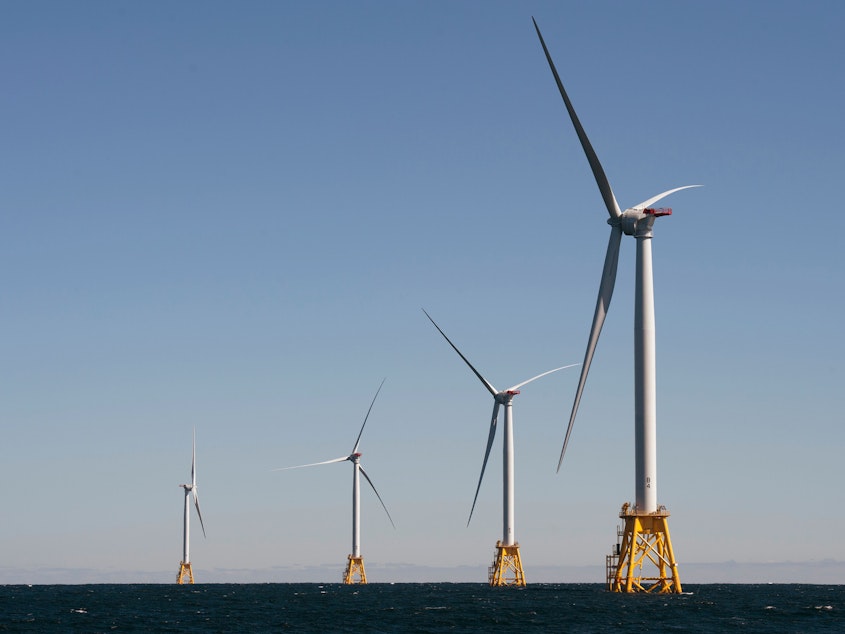Biden Administration Strikes A Deal To Bring Offshore Wind To California

The Biden administration plans to open the California coast to offshore wind development, ending a long-running stalemate with the Department of Defense that has been the biggest barrier to building wind power along the Pacific Coast.
The move adds momentum to the administration's goal of reaching 100% carbon-free electricity by 2035, coming just weeks after the country's first large-scale offshore wind farm was approved off the coast of New England. Today, the country has just a handful of offshore wind turbines in the Atlantic Ocean, with around a dozen wind farms being developed in federal waters off the East Coast.
Updated May 25, 2021 at 2:56 PM ET
"It's an announcement that will set the stage for the long-term development of clean energy and the growth of a brand-new, made-in-America industry," national climate adviser Gina McCarthy says. "Now we're thinking big and thinking bold."
The agreement identifies two sites off central and Northern California with the potential to install massive floating wind turbines that could produce 4.6 gigawatts of electricity, enough to power 1.6 million homes.
Sponsored
Interest in offshore wind on the West Coast has grown for years, especially with California's own ambitious goal to cut greenhouse gas emissions. The deep waters off the coast have the potential to produce a significant amount of energy.
But the Defense Department has largely objected to the idea since the Navy and Air Force use the area for training and testing operations. In response to the growing interest, the Navy released a map in 2017 putting large swaths of California waters off-limits.
In 2018, the federal Bureau of Ocean Energy Management solicited interest from wind developers. But negotiations with the Defense Department have been slow going ever since, effectively blocking wind development off California.
Tuesday's announcement outlines a compromise for a 399-square-mile area off Morro Bay, a site that's appealing to renewable energy companies because of existing transmission lines nearby that once serviced a retired power plant. It also identifies a location off Humboldt County in Northern California.
"It's our view that the world faces a grave and growing climate crisis," says Colin Kahl, undersecretary of defense for policy. "Climate change is both a threat to the Department of Defense's operations around the world and an existential challenge to our ability to maintain resilience here at home."
Sponsored
Another key site, just offshore from the Diablo Canyon nuclear power plant, was not included in Tuesday's deal. California's last-remaining nuclear plant is scheduled to close completely by 2025, freeing up more potential transmission lines for offshore wind.
The Biden administration has set a goal of jump-starting the country's offshore wind sector with 30 gigawatts of projects by 2030. Those wind farms will foster tens of thousands of jobs, according to the White House, between renewable energy installers, manufacturers and steelworkers.
"This is a major breakthrough — a major advancement that will allow California to start planning for its carbon-free electricity goals with offshore wind firmly in the picture," says Nancy Rader of the California Wind Energy Association, who also pointed to the challenges. "Offshore wind development off the coast at Morro Bay and Humboldt will require a major port facility in each area to construct the floating platforms and assemble the turbines that will require continued proactive planning by the state and federal governments."
Still, the areas identified in the agreement may not be enough for hitting the administration's clean electricity goal as well as California's. The state is planning to get 100% of its electricity from zero-emission sources by 2045. To reach that, renewable energy needs to triple statewide with offshore wind playing a key role, reaching 10 gigawatts, according to a recent state analysis. Tuesday's deal could provide just half of that.
A potential lease auction for the offshore wind sites could be held in mid-2022. But the projects will still have to negotiate concerns about the potential impact on California's fishing industry and shipping channels as well as any environmental concerns about sensitive ecosystems.
Sponsored
"Far too many questions remain unanswered regarding potential impacts to marine life, which is dependent on a healthy ecosystem," says Mike Conroy of the Pacific Coast Federation of Fishermen's Associations. "The fishing industry has been told these areas work best for offshore wind developers, but no one has asked us what areas would work best for us." [Copyright 2021 NPR]



